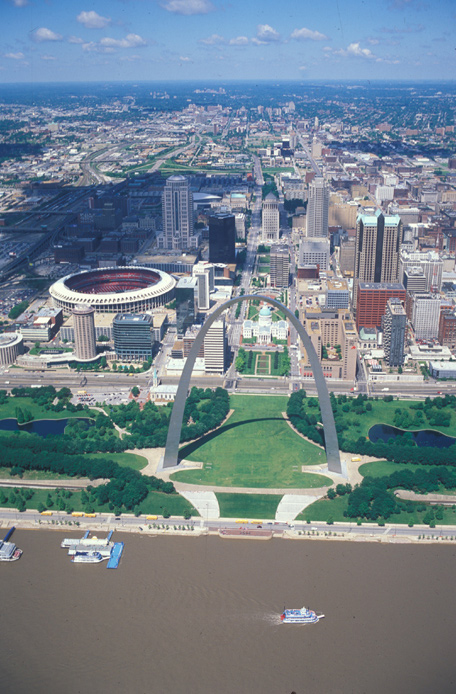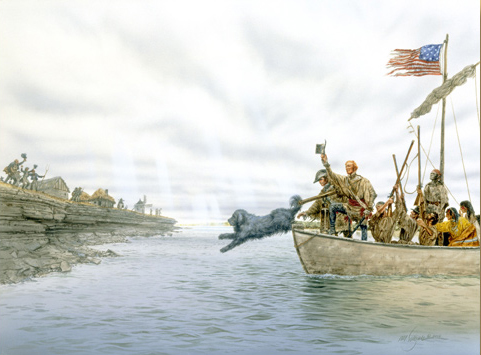Arrival in 1803
On 7 December 1803, after stopping at old Cahokia, Illinois (population then about 700), the expedition moved past “the American bottom” on the U.S. side of the Mississippi, to the vicinity of today’s East St. Louis, Illinois. On the eleventh, Clark wrote to his brother, they “proceeded on”[1]This was the first occurrence of the phrase that was to become a motif and motto in the history of the expedition, occurring 658 times in the several diaries, going and coming. across the Mississippi “to a landing opposite the center of the Town.” That would have been at the foot of St. Louis’s Market Street, which extended to the river’s edge, just inside the south (left, in the photo) leg of the famous Gateway Arch. The arch was built in the early 1960s to commemorate significant events in America’s westward expansion, including the Lewis and Clark Expedition.
Word of the expedition’s departure had spread quickly. “The admiration of the people were So great, that hundreds Came to the bank to view us,” Clark later wrote. St. Louis’s population was around one thousand at the time.
When the Corps of Discovery returned on 23 September 1806, crammed into five canoes and one of the two original pirogues, they were “met by all the village and received a harty welcom from its inhabitants” on the riverbank at the foot of Market Street. In the last of his 863 consecutive daily entries, Sgt. John Ordway wrote that the men “drew out the canoes then the party all considerable much rejoiced that we have the Expedition Completed . . . . we entend to return to our native homes to See our parents once more as we have been So long from them.”
The next morning Lewis and Clark began writing to their commander-in-chief, and to their families. Their stories quickly took root in American history. On the same ground where the Corps landed, beneath today’s Gateway Arch, the two captains resided for the rest of their lives.
Return in 1806
Artist Michael Haynes based the expedition’s homecoming on a sketch of the limestone bank that formed the St. Louis riverfront in the 1820s—no earlier image being known—and has shown the Mississippi at or near its usual low autumn level. Lewis’s dog Seaman is the first to disembark, leaping from beneath from his master’s restraining hand at the bow of the white perogue, while Clark exchanges salutes with the townspeople, the mixture of Anglos and Creoles who rush to welcome the returning heroes. Behind the captains, two of the Corps fire salutes from their rifles. Beneath the tattered, travel-worn flag, Clark’s servant York leans against the mast with rifle poised as if to show onlookers the status he has earned during the journey—blacks were not permitted to carry guns in those days. At York’s left are the Mandan Chief Sheheke (Big White) and Yellow Corn, who were en route to Washington City to meet President Thomas Jefferson.
Near the riverbank is the large stone-and-timber building that was the warehouse of the French-Canadian merchant and frontiersman Jean Gabriel Cerré (1734-1805), who outfitted many hunters and traders between 1755, when as a 21-year-old immigrant he opened his business in Kaskaskia, Illinois, until his death in St. Louis in 1805. The two thatched-roof buildings beyong it are slave quarters. The Roy Mill is silhouetted in the distance.
The Memphis of America
Practically every new community on the western frontier was born with high hopes. Comparisons with the cities of ancient civilizations were invoked as role models by proud city fathers who dreamed their sons would grow up to be the president. Situated on the west bank of the mighty Mississippi River between the mouths of the Ohio and the Missouri, St. Louis, from its beginning in 1764, held the promise of becoming a nodal point in transcontinental commerce. Indeed, its founder, Pierre Laclede Liguest, predicted, “This settlement will become one of the finest cities in America.” By the year 1811 Henry Marie Brackenridge’s vision was somewhat clearer and even more far-reaching:
St. Louis, will probably become one of those great reservoirs of the valley between the Rocky mountains and the Alleghany, from whence merchandise will be distributed to an extensive country. It unites the advantages of the three noble rivers, Mississippi, Illinois and Missouri. When their banks shall become the residence of millions, when flourishing towns shall arise, can we suppose that every vender [sic] of merchandise, will look to New Orleans for a supply, or to the Atlantic cities? There must be a place of distribution, somewhere between the mouth of the Ohio and the Missouri. Besides a trade to the northern parts of New Spain will be opened, and a direct communication to the East Indies, by way of the Missouri, may be more than dreamt: in this, St. Louis will become the Memphis of the American Nile.[2]Henry Marie Brackenridge, Views of Louisiana, Together with a Journal of a Voyage up the Missouri River, in 1811 (1814; reprint, Chicago: Quadrangle Books, 1962), 124. In 1804, according to Captain … Continue reading
The Mississippi is rarely compared with Africa’s Nile anymore. On top of that, in 1819 Andrew Jackson and two of his cronies pre-empted the name Memphis for their real estate venture by the Mississippi in the young state of Tennessee. As people moved westward into the new territory, other cities-to-be along the Missouri would temporarily gain the hyperbolic designation of “gateway city,” but no other place has merited a 630-foot-high arch designed by the great Finnish architect Eero Saarinen as a permanent, world-renowned symbol of a city and its history.
For more, see on this site St. Louis and Winter at St. Louis.
From Discovering Lewis & Clark from the Air
Photography by Jim Wark
Text by Joseph Mussulman
Reproduced by permission of Mountain Press
In present St. Louis, the Jefferson National Expansion Memorial “commemorates Thomas Jefferson’s vision of the continental expansion of the United States” and is a High Potential Historic Site along the Lewis and Clark National Historic Trail managed by the U.S. National Park Service.—ed.
Notes
| ↑1 | This was the first occurrence of the phrase that was to become a motif and motto in the history of the expedition, occurring 658 times in the several diaries, going and coming. |
|---|---|
| ↑2 | Henry Marie Brackenridge, Views of Louisiana, Together with a Journal of a Voyage up the Missouri River, in 1811 (1814; reprint, Chicago: Quadrangle Books, 1962), 124. In 1804, according to Captain Amos Stoddard, who presided at the transfer of upper Louisiana to the U.S., the population of St. Louis was 9,373, including 1,497 slaves. In 2000 the total population of the city was 348,189. |
Experience the Lewis and Clark Trail
The Lewis and Clark Trail Experience—our sister site at lewisandclark.travel—connects the world to people and places on the Lewis and Clark Trail.
Discover More
- The Lewis and Clark Expedition: Day by Day by Gary E. Moulton (University of Nebraska Press, 2018). The story in prose, 14 May 1804–23 September 1806.
- The Lewis and Clark Journals: An American Epic of Discovery (abridged) by Gary E. Moulton (University of Nebraska Press, 2003). Selected journal excerpts, 14 May 1804–23 September 1806.
- The Lewis and Clark Journals. by Gary E. Moulton (University of Nebraska Press, 1983–2001). The complete story in 13 volumes.





